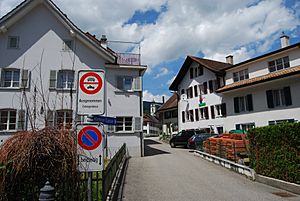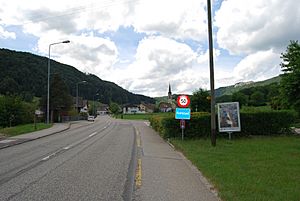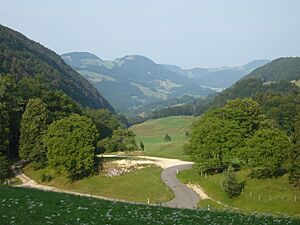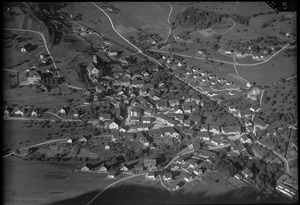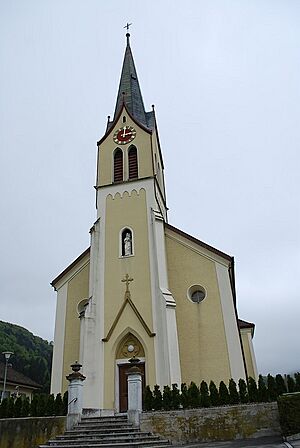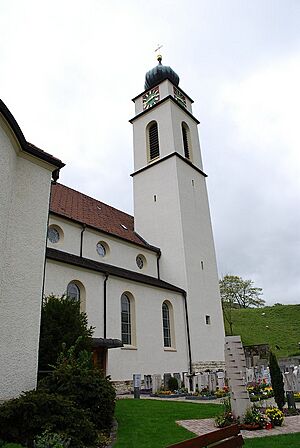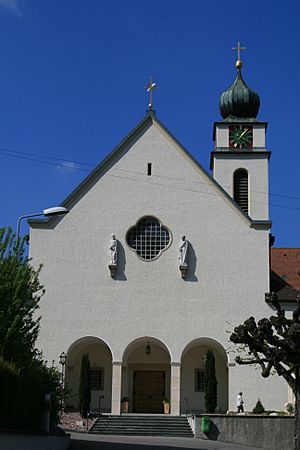Mümliswil-Ramiswil facts for kids
Quick facts for kids
Mümliswil-Ramiswil
|
||
|---|---|---|
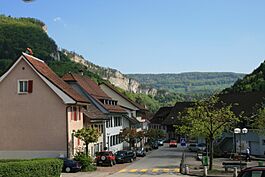
Mümliswil village
|
||
|
||
| Country | Switzerland | |
| Canton | Solothurn | |
| District | Thal | |
| Area | ||
| • Total | 35.48 km2 (13.70 sq mi) | |
| Elevation | 556 m (1,824 ft) | |
| Population
(Dec 2020 )
|
||
| • Total | 2,386 | |
| • Density | 67.249/km2 (174.17/sq mi) | |
| Postal code |
4717 Mümliswil, 4719 Ramiswil
|
|
| Surrounded by | Aedermannsdorf, Balsthal, Beinwil, Holderbank, Langenbruck (BL), Laupersdorf, Lauwil (BL), Matzendorf, Reigoldswil (BL), Waldenburg (BL) | |
Mümliswil-Ramiswil is a municipality in the Thal district. It is located in the canton of Solothurn in Switzerland.
Contents
History of Mümliswil-Ramiswil
Mümliswil-Ramiswil has a long history. Mümliswil was first mentioned in old writings in 1145. It was called Mumliswilre back then. Ramiswil appeared a bit later, in 1147. These early mentions show how old these villages are!
Geography of Mümliswil-Ramiswil
Mümliswil-Ramiswil covers a large area of about 35.5 square kilometers. A big part of this land, about half, is used for farming. Almost as much is covered by forests. Only a small part has buildings and roads.
The municipality is located in the beautiful Gulden valley. This valley sits between two Jura mountain chains. It is also on important routes like the Passwang Pass and the Schelten Pass.
Mümliswil-Ramiswil is the largest municipality in the Canton of Solothurn by area. It includes the main villages of Mümliswil and Ramiswil. You can also find many smaller hamlets and individual farmhouses here.
Coat of Arms of Mümliswil-Ramiswil
The coat of arms for Mümliswil-Ramiswil is quite special. It shows a golden shield split down the middle. On one side, there is a black shepherd's crook with the letter "M" at the top. This might represent the church or local traditions. The other side has three horizontal stripes. These stripes are black, silver, and red.
Population and People of Mümliswil-Ramiswil
Mümliswil-Ramiswil has a population of about 2,500 people. Most people in the municipality speak German. This is the main language spoken by almost everyone. Other languages like Serbo-Croatian and Albanian are also spoken by smaller groups.
Most of the people living here were born in Mümliswil-Ramiswil. Many others were born in the same canton, Solothurn. A smaller number of people moved here from other parts of Switzerland or from other countries.
The population has changed a little over the years. Sometimes it grows, and sometimes it shrinks slightly. The chart below shows how the population has changed over a long time.

Economy and Jobs in Mümliswil-Ramiswil
The economy in Mümliswil-Ramiswil involves different types of jobs. Many people work in the primary sector. This means they work in farming or forestry. There are also jobs in the secondary sector. These jobs include manufacturing and construction.
A good number of people work in the tertiary sector. This sector includes jobs like sales, transportation, and working in hotels or restaurants. Some people also work in education or healthcare.
Many residents of Mümliswil-Ramiswil travel to other towns for work. Fewer people travel into the municipality for their jobs. This means more people leave for work than come in. Most people use a private car to get to their jobs. Some also use public transportation.
Religion in Mümliswil-Ramiswil
Most people in Mümliswil-Ramiswil are Roman Catholic. A smaller group belongs to the Swiss Reformed Church. There are also people who follow other Christian faiths, like Orthodox Christianity. Some residents are Islamic. A small number of people do not belong to any church.
Education in Mümliswil-Ramiswil
The education system in Mümliswil-Ramiswil follows the rules of the Canton of Solothurn. Young children can attend two years of Kindergarten, which is not required. After kindergarten, students go to six years of primary school.
For secondary school, students attend three years of required schooling. After that, they can choose to go to optional advanced schools. All students from Mümliswil-Ramiswil who are in lower secondary school attend classes in a nearby municipality.
See also
 In Spanish: Mümliswil-Ramiswil para niños
In Spanish: Mümliswil-Ramiswil para niños





